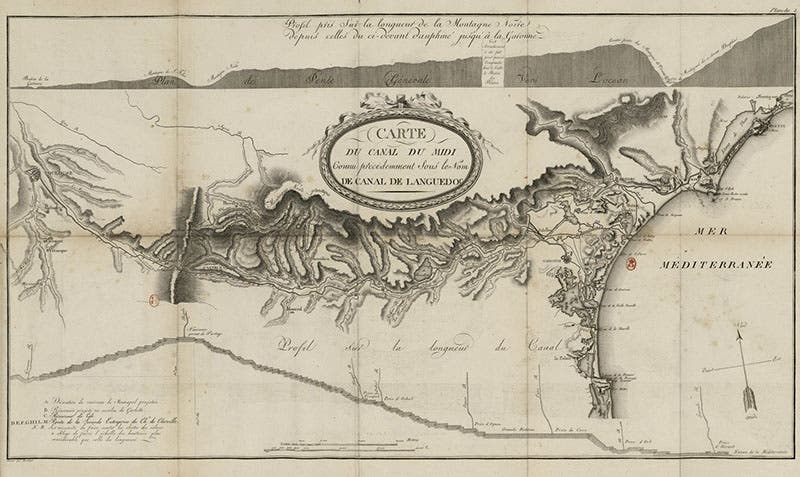Scientist of the Day - Pierre-Paul Riquet
Pierre-Paul Riquet, a French civil engineer, was born June 29, in either 1604 or 1609. Riquet became quite rich as a fermier général (tax collector) in southeastern France, but he used his wealth to finance the greatest engineering project of the 17th century, the building of a canal that connected the Mediterranean Sea to Toulouse, which sat on a navigable river, the Garonne, that ran to the Bay of Biscay and the Atlantic Ocean. Called the Languedoc Canal, it was 150 miles long and had to cross a watershed at an altitude of 625 feet. We link here to a modern map of the region, with the Languedoc Canal (here labeled the Canal du Midi, explanation below) marked in blue. Begun in 1667, the Canal opened for traffic on May 20, 1681.
The principal problems facing Riquet, once he had convinced King Louis XIV and his Minister of Finance Jean-Baptiste Colbert of the viability of the project, were designing and building approximately 91 locks (actually the easier set of problems) and finding water to supply the locks, especially those at the summit (the hard part). Work began in 1667, and Riquet hired an assistant, François Andréossy, an experienced hydraulics engineer, to handle much of the technical work. The water supply problem was solved first, by building a huge dam near the summit to form a large reservoir to supply water for the locks. Just building the earthen dam was one of the largest construction projects ever undertaken in early modern Europe. The locks also presented difficulties, as they kept collapsing when emptied of water, until Riquet gave them a pleasing and stronger lozenge shape, as we see in this modern photo. Some of the locks were built in staircase chains that look impressive even today (first image). In addition, numerous bridges had to be built so that roads could cross, and the canal itself had to pass over 3 rivers, each of which required a substantial aqueduct, such as this one, and a tunnel was needed as well, the Malpas tunnel, the first navigable canal tunnel anywhere. When one considers that the only precedent for the Languedoc canal was the Canal de Briare, which connected the Loire and Seine river systems, was completed in 1642, and was all of 35 miles long, one gets a better appreciation for Riquet's vision and his problem-solving skills. The canal was finished in 1681, after 14 years of construction, but Riquet was not present at the opening, having died in 1680.
After the French Revolution, the name of the Languedoc Canal was changed to the Canal du Midi, “the canal between the two seas”. In 1800, Comte Antoine-François Andréossy, a veteran of Napoleon’s expedition to Egypt, wrote the first book about the building of the canal, Histoire du Canal du Midi, ou Canal de Languedoc. The book was greatly enlarged in 1804 with the addition of numerous maps and sections, and that is the edition that we have in the Library. The 2nd volume has 29 large folding plates; we link to one (not in our copy, which is unavailable during the closure) that shows the terrain between the Mediterranean and the Atlantic – Toulouse is at bottom center. We reproduce here a second map (second image), this one showing just the path of the Canal du Midi, with Toulouse now at the far left, and including several diagrams showing the change in elevation of the canal as it crossed the continental divide. One of Andréossy's reasons for writing his book was to demonstrate, or at least argue, that his great-grandfather, François Andréossy, was really the man responsible for building the canal, and that Riquet, who was merely a very rich tax collector, simply took all the credit. Most historians now seem to give both men a great amount of credit for the enterprise, although we do note that Riquet has a statue in Toulouse, and as far as I can tell, Andréossy does not. Riquet also has a memorial plaque in Toulouse Cathedral.
We exhibited this book in 2002 in our Centuries of Civil Engineering exhibition, where you can see that the younger Andréossy gave us a portrait of the ancestral Andréossy, but not Riquet; you can also see another plate with a profile of part of the canal; click on either image to enlarge a little. The Canal du Midi was named a World Heritage Site in 1996; you can see 15 additional photos, some of them quite lovely, of what is now a recreational canal on the WHS website.
Dr. William B. Ashworth, Jr., Consultant for the History of Science, Linda Hall Library and Associate Professor emeritus, Department of History, University of Missouri-Kansas City. Comments or corrections are welcome; please direct to ashworthw@umkc.edu.







